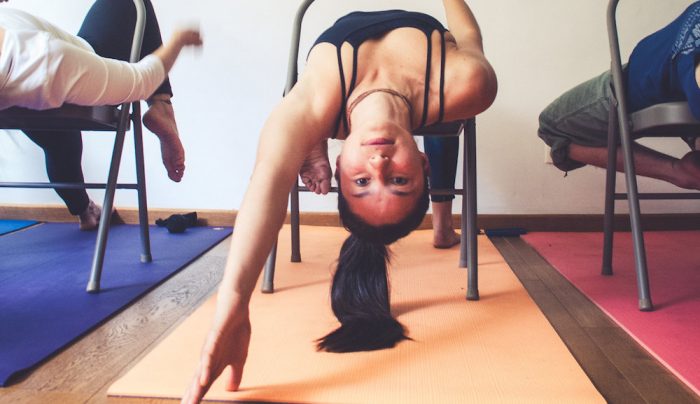Some of us practice yoga because it’s “good for anxiety.”
But, like so many things, anxiety has a cognitive component and a physical one. The two components cause each other, like chickens and eggs. Yoga is as effective as it is because it addresses both.
The thing about the cognitive side of anxiety is that often, the more directly you talk about it, the less true your words start to feel. So for today, we’re going to talk about the physical side of anxiety and yoga, especially in terms of cortisol; if cognitive improvements come along, all the better.
Cortisol is a hormone like estrogen, testosterone, or adrenaline. Although plenty of hormones are involved in the anxiety process, cortisol usually gets nicknamed “the stress hormone” because it’s responsible for so much of the stress experience.
Its major purpose is to help us see danger coming and then fight it, flee from it, or freeze to hide from it. It does this, among other ways, by pausing the bodily systems that aren’t meant to help with danger, like digestion. This frees up the energy that would have been spent on digestion so we can use it to fight, flee, or freeze better.
When we register that the danger has passed and our breathing and heart rates slow down, our cortisol producers take the cue and turn their knobs back down toward their normal levels. Then, without so much cortisol inhibiting them, the other systems like digestion can come back online.
It’s just that sometimes, we give them…less-than-convincing cues. We stop running for our lives but keep taking quick, shallow breaths as if we might have to jump up and run again soon. Again, our bodies take the cues we give them—they produce less cortisol but still more than we need during peacetime, because we’re signaling, however subtly, that we’re probably about to need it.
This is fine and sometimes even preferable for a while after a dangerous experience. A soldier who saw action yesterday might see more today and tomorrow, for example. It’s when there isn’t any danger that all that cortisol gets to be a bother.
Our other systems—reproduction and immunity as well as digestion—remain inhibited, even if they’re not on full pause anymore. Our various functions aren’t supposed to be hindered like that for so long; over time, they start to wear down. This is one of the ways chronic stress hurts our health.
In these times, it’s up to our conscious selves to help our unconscious selves finish their return to homeostasis. Taking a long, slow breath into the bottom of the lungs is something our bodies know we can’t do when there’s a tiger on top of us, taking a big bite of trachea. So when there are no tigers around, we take time to breathe this way on purpose, to show our bodies we’re safe.
And we take another slow, mindful breath, proving that the first one wasn’t a fluke. If you’ve been anxious for a long time, your muscles might be tense; it’s like they got into a ready position and stayed there long enough to rust. So we stretch into our muscles gently—luxuriously, even—and breathe this calmness into them. Again, you can’t do that, at least not for long, when you’re being eaten by a monster.
It’s in this way that we do yoga to show our bodies that we’re safe. We assure our cortisol producers that we don’t want to get eaten any more than they do, and we promise they can go crazy again the moment there’s another incident. But for now, we’re taking another, even longer, even slower breath.
Missing safeness—wanting it so badly that we’re willing to do whatever it takes to return to it—that’s the point of fear. But the other half of the deal is that when we get our safety back, the fear will subside accordingly.
Your body wants to keep that promise. If it hasn’t yet, it just doesn’t trust that it can.
Show it faithfully, lovingly, patiently. In time, it will come to understand.


 Share on bsky
Share on bsky





Read 1 comment and reply